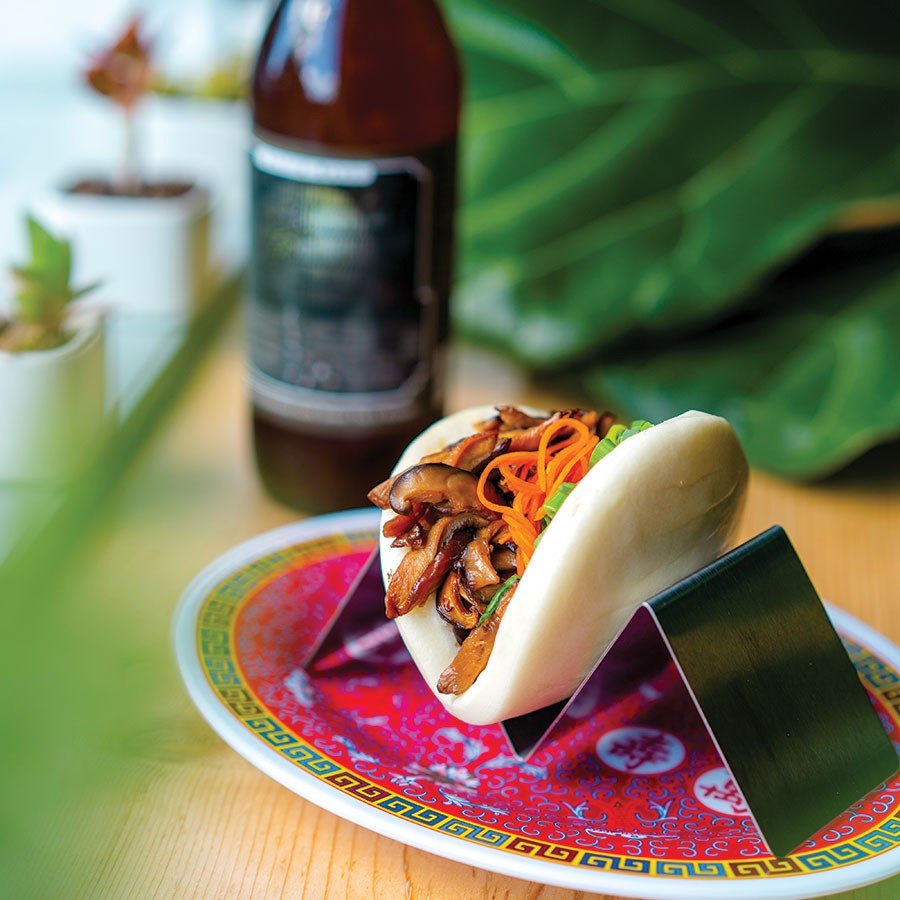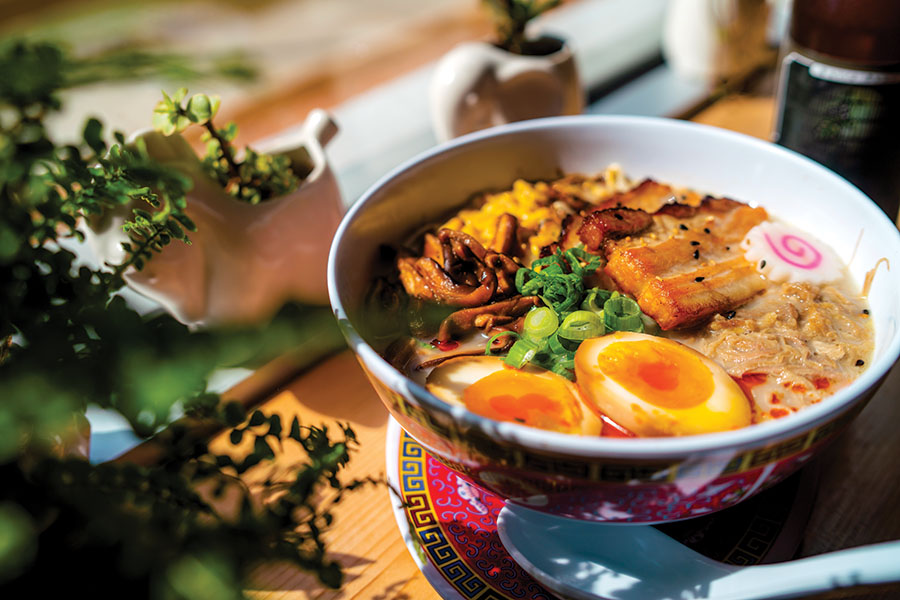When attempting to describe umami, Pam Smith can’t quite put her finger on it. Even as a registered dietitian nutritionist, the co-founder of Gumpel’s Searing Spices, and a former lecturer at the Culinary Institute of America, she too must employ half measures to pin down the word—dancing around the definition with synonyms that come close but ultimately fall short. “There’s really not a suitable word for it in the English language,” she says, “but it’s an unctuousness or craveability in a dish.”
The elusive essence of umami manages to coexist right alongside the peer-reviewed science that helps explain it—another indication of its confounding nature. “There’s a nucleopeptide called glutamate that’s at the heart of umami,” says Smith, referring to the protein first isolated by Japanese chemist and foodie Kikunae Ikeda in 1908. Smith continues her TED Talk with the physiology of taste using technical jargon about neuroreceptors on the lips and tongue—“the idea of taste regions in the mouth is not true, by the way,” she says. Still, the way she tells it, umami is understood more by its anecdotal effects than by any clear, explicit quality.
As the Umami Information Center (a nonprofit organization that studies and compiles the science behind umami) asserts, the close association of the taste with Japanese cuisine likely stems from its unadulterated existence in many Japanese dishes. Umami is also studied primarily by Japanese scientists. The Center corroborates Smith’s quick list of glutamate-rich foods like seaweed, soy sauce, miso, dried bonito flakes, shiitake mushrooms, green tea and cooked meat. These ingredients all contribute to essential Japanese staples like dashi soup base, teriyaki and sushi. “A ramen noodle soup is definitely the pinnacle of umami, especially a really authentic one that’s been simmering for a long time,” Smith says. But, as she moves beyond Japanese cuisine in her pontifications, she reveals that umami hides in unsuspecting places.
“Tomatoes have the essential nucleopeptides too, so think about a pasta dish with bolognese sauce,” she says, “then maybe add mushrooms and some grated parmesan (both high in glutamates)—that’s definitely an umami bomb.” Considering how quickly Napulé became a Sarasota staple for Southern Italian food, the restaurant’s Gnocchi Bolognese seems like a good dish in which to start hunting for umami’s essence. Without any special requests, the dish already educes that savory mouthfeel to which Smith refers; but, since Napulé’s food is all made from scratch, ample room is afforded to experiment. At Smith’s insistence, a handful of diced porcini mushrooms or perhaps a drizzle of truffle oil (or both) would take the dish to new umami heights—or depths?—but it’s the freshly grated parmesan cheese that brings the greatest concentration of glutamates. “The aging process releases even more glutamates,” Smith says—so much so that aged parmesan cheese has as high a concentration as many of the seaweeds commonly known for their umami-like kombu. So, when the server arrives with a cheese grater to top off the Gnocchi Bolognese, the search for umami requires that the server grate until the cheese spills over the edge of the plate.
The experience of umami is there—the salivating, the way the taste makes you eat more than you should—but the line between the Gnocchi Bolognese and soy sauce, for example, seems speculative. How can Smith or any other food expert explain the existence of such a line?
“If you look at all the dishes people tend to salivate over, it’s oftentimes comfort food,” says Smith, “so think of a hamburger too, or better yet, a hamburger with mushrooms and ketchup.” The beef in a burger seems obvious, as do mushrooms with their savory funkiness. But regular store-bought ketchup? The red, gooey, processed condiment that comes in a packet? The tomatoes would certainly help ketchup achieve its umami attributes much like the bolognese sauce, but the real gateway comes from the “natural flavors”—an alternative name for an ingredient that continues to be misunderstood in 2021: monosodium glutamate, or MSG.

The misunderstanding around MSG stems from a letter published in The New England Journal of Medicine in 1968. Its author correlated a set of symptoms like brain fog, headaches and nausea with the consumption of MSG. He called this set of symptoms “Chinese restaurant syndrome” after purporting, with no evidence, that Chinese food contained high levels of the flavor enhancer. The subsequent media frenzy spawned the misinformed attitudes toward MSG today. “Chinese restaurant syndrome has been largely disproven,” Smith says, “but it still has the poison mark attached to it. ”
Returning to less controversial topics like ketchup and burgers, Shakespeare’s English Pub offers a suitable entry into umami nirvana. A whopper-ing four burgers on the menu come with mushrooms, but the Garlicky Mushroom Burger seems like the most straightforward combination of beef and fungi that would lead to high glutamate numbers. Garlic also has its fair share of the compound to pair with the mushrooms and beef, and that’s before adding the aforementioned ketchup. The resulting explosion of savoriness is undeniable, as is the mouthwatering silkiness that makes it slide down the gullet with gusto. “With umami, what you want is to mix and match so you get a lifting up of the whole experience,” Smith says. No matter how lofty the umami, the massive half-pound burger inspires sitting, and plenty of it. And the dark-walled, dimly lit interior of the pub encourages a certain meditative state that might help uncover that fabled line between a gnocchi bolognese, a burger with mushrooms and Japanese staples. But, like Smith said, the essence of umami is less a quantifiable throughline and more a collection of feelings and impressions. Both dishes are meaty and savory, sure, but otherwise, it’s the salivating and deep contentment that unite the two meals.
A clear connection can also not be made between the burger and the dish many assert defines umami itself: a bowl of tonkotsu ramen noodle soup. For this transformative experience, the Tonkotsu Ramen Soup from Fushipoké is rumored to be the best in town.
“Tonkotsu” means “pork bones” and, unsurprisingly, pork bones form the base of the broth (along with more than five pounds of shiitake mushrooms), according to Fushipoké Owner and Operator Tyler Fushikoshi. The resulting stock gets skimmed and strained for silkiness but still achieves an opacity from the rich particles that survive the straining process. Its savoriness is also bolstered by the marrow and collagen of the bones rendered into liquid. This is a potion of immense complexity, delicate yet accessible despite the mysterious chemistry that compounds the flavors. When served, the ramen noodles are added along with a soy-marinated and poached egg, garlic and chili oils, slivers of shiitake mushrooms, diced scallions, sesame seeds, bean sprouts and a whimsical little slice of narutomaki (a cured fish cake with a pink swirl in its center).
In the rich opacity of the tonkotsu exists a more developed iteration of what Smith referred to as a “lifting up” of the experience. Every ingredient seems to multiply the dichotomous silkiness and heft that umami evokes. With the option of adding thick slices of pork belly, the bowl eats with all the appetizing appeal of a grilled steak. But the mix of textures, and the fact that so much of the umami is concentrated in the broth itself, takes it far beyond the reach of all seared meats (with the exception of maybe smoked brisket). After the tonkotsu, the bolognese and the burger, umami has revealed itself without revealing itself. Smith’s need to resort to synonyms and half measures like “savory” (which comes close) or “unctuous” (which comes a little closer) rings true. Ultimately, umami is a set of feelings: full, happy and wanting more. “When it’s layered just right, it’s more than just one plus one equals two,” Smith says. “It’s truly memorable. That’s why I call umami the fifth experience in food.” SRQ










